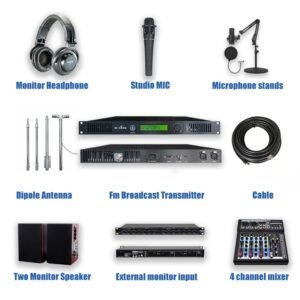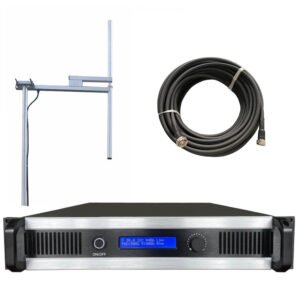How to increase FM transmitter coverage?
Your FM transmitter isn’t reaching far enough to serve your target audience. Poor coverage means lost listeners and wasted broadcasting investment. The right coverage techniques can double or triple your broadcasting range.
Increase FM transmitter coverage by raising antenna height, using quality cables, and choosing optimal transmitter power. Higher antennas add 2-3 miles per 10 feet of height. Professional installation and proper grounding maximize signal strength.
%(FM transmitter coverage increase)How to increase FM transmitter broadcasting coverage
I’ve helped hundreds of radio stations expand their coverage over the past decade. The most dramatic improvements come from simple antenna system upgrades. Let me share the proven methods that work in real installations worldwide.
How can I boost my FM transmitter signal?
Your signal strength isn’t reaching listeners in distant areas. Weak signals create static and dropouts for your audience. Strong, clean signals keep listeners tuned in and engaged with your programming.
Boost FM transmitter signal by increasing antenna height, upgrading to low-loss cables, and optimizing transmitter power output. Professional antenna installation can improve signal strength by 3-6 dB, effectively doubling coverage area.
%(FM transmitter signal boosting)FM transmitter signal strength improvement
The biggest signal improvements come from antenna system upgrades. I worked with a church in rural Texas that doubled their coverage from 8 miles to 16 miles just by moving their antenna from 40 feet to 80 feet height. The transmitter power stayed the same at 100 watts, but the higher antenna made all the difference.
Signal boosting requires understanding the complete transmission chain. Your transmitter generates the signal, cables carry it to the antenna, and the antenna radiates it to listeners. Weakness at any point reduces your overall performance. Most stations lose 20-30% of their power in poor cables and connections.
Our RS transmitters include adjustable power output that helps optimize signal strength. The RS-FM1000W adjusts continuously from 0-1000 watts in 0.1-watt steps. This means you can start at 50 watts for testing and gradually increase to find the optimal power for your coverage area. The built-in SWR protection automatically reduces power if antenna problems develop.
At RS, we recommend these signal boosting priorities in order of importance:
| Method | Improvement | Cost Level |
|---|---|---|
| Antenna height increase | +3-6 dB | High |
| Quality coaxial cable | +2-4 dB | Medium |
| Professional grounding | +1-3 dB | Low |
| Proper impedance matching | +1-2 dB | Low |
| Transmitter power upgrade | Variable | High |
| Antenna pattern optimization | +1-3 dB | Medium |
The first three items give you the biggest improvements for your investment. A customer in Nigeria increased their signal strength by 8 dB just by addressing antenna height, cable quality, and grounding. Their coverage went from 6 miles to 18 miles without changing transmitter power.
How can I make my FM transmitter sound better?
Your audio sounds distorted or noisy compared to professional radio stations. Poor sound quality drives listeners away to competing stations. Crystal clear audio keeps audiences engaged and builds your station’s professional reputation.
Improve FM transmitter sound quality with proper audio processing, correct modulation levels, and quality audio cables. Professional audio processors enhance clarity while preventing over-modulation that causes distortion and interference.
%(FM transmitter audio quality)FM transmitter sound quality improvement
Sound quality problems usually come from three main sources: poor audio input, incorrect transmitter settings, or RF interference. I’ve seen stations transform their audio quality with simple adjustments to modulation levels and input filtering. The difference is immediately noticeable to listeners.
Our newer RS transmitters use DSP Digital Sound Processing technology that makes a huge difference in audio quality. The RS-FM1000W and RS-FM2000W include digital filtering, pre-emphasis, stereo coding, and FM modulation all processed digitally. This eliminates the noise and distortion common in older analog transmitters.
The DSP system automatically manages audio levels with built-in AGC circuits that keep power stable. Digital processing ensures your station sounds professional without the complexity of external audio processors. A customer in Kenya told me their listeners immediately noticed the improved sound quality after upgrading to our DSP transmitter.
| Problem | Solution | Difficulty |
|---|---|---|
| Distorted audio | Reduce input levels | Easy |
| Weak signal | Increase modulation | Medium |
| Background noise | Input filtering | Medium |
| Frequency response | EQ adjustment | Easy |
| Stereo separation | Phase alignment | Hard |
| Dynamic range | Compression | Medium |
Professional audio processing includes compression that keeps your station’s loudness competitive with major broadcasters. The built-in processing eliminates the need for expensive external equipment while delivering broadcast-quality sound that keeps listeners engaged.
What is the best frequency for an FM transmitter?
You need to choose the right frequency for your FM transmitter but don’t know which one works best. Wrong frequency choice causes interference problems and legal issues. The right frequency ensures clear reception and regulatory compliance.
The best FM transmitter frequency depends on local regulations and interference levels. Lower frequencies (87-94 MHz) travel slightly farther but have more interference. Higher frequencies (100-108 MHz) offer clearer channels in most areas.
%(FM frequency selection)Best FM transmitter frequency selection guide
Frequency selection involves balancing propagation characteristics, interference levels, and legal requirements. In most countries, you must use approved frequencies that don’t interfere with existing stations. The licensing authority assigns specific frequencies based on your location and power level.
All RS transmitters cover the complete FM band from 87.5-108 MHz with 10 KHz frequency steps. The carrier frequency precision is ±200Hz, which exceeds most international broadcasting standards. This precision prevents drift that causes interference with adjacent channels.
Lower FM frequencies do travel slightly farther due to better ground wave propagation. A 100W transmitter on 88.1 MHz typically reaches 10-15% farther than the same transmitter on 107.9 MHz. However, the lower band often has more interference from other stations and services.
I always recommend checking local frequency usage before choosing your operating frequency. A customer in Kenya found that 89.5 MHz was completely clear in their area, giving them excellent coverage. Another customer in Mexico had to use 105.7 MHz to avoid interference from border stations.
| Frequency Range | Characteristics | Best Use |
|---|---|---|
| 87.5-90.0 MHz | Longer range | Rural areas |
| 90.1-94.0 MHz | Good propagation | Suburban areas |
| 94.1-98.0 MHz | Balanced performance | General use |
| 98.1-102.0 MHz | Clear in most areas | Urban areas |
| 102.1-108.0 MHz | Least interference | Dense markets |
Our transmitters allow easy frequency changes through front panel controls. You can test different frequencies to find the clearest channel in your area. The frequency steps are fine enough to avoid interference while staying within legal limits.
Is a longer FM antenna better?
You think a longer antenna will improve your FM transmitter performance. Random antenna lengths often reduce performance instead of improving it. Proper antenna length depends on frequency and design, not just overall size.
FM antenna length must match specific wavelength ratios for optimal performance. Quarter-wave, half-wave, and 5/8-wave antennas work best. Random lengths create poor impedance matching and reduced radiation efficiency that hurts coverage.
%(FM antenna length optimization)FM antenna length vs performance
Antenna length calculations depend on your operating frequency. For example, a quarter-wave antenna for 100 MHz measures exactly 29.25 inches. A half-wave antenna at the same frequency is 58.5 inches. These specific lengths create resonance that maximizes radiation efficiency and signal strength.
The most popular FM antenna lengths are quarter-wave and 5/8-wave designs. Quarter-wave antennas are compact and work well for most applications. 5/8-wave antennas provide slightly more gain and better radiation patterns but require more mounting height and careful installation.
Professional antenna systems must match your transmitter’s output impedance. All RS transmitters use 50-ohm output impedance that requires proper impedance matching for maximum power transfer. Poor matching creates high SWR that triggers our built-in protection circuits.
I’ve seen many customers try random wire lengths thinking longer equals better. A customer in Nigeria used a 10-foot wire antenna and got poor results. We replaced it with a proper 5/8-wave antenna cut for their frequency. Coverage improved from 3 miles to 12 miles with the same transmitter power.
| Antenna Type | Length at 100MHz | Gain |
|---|---|---|
| 1/4 wave | 29.25 inches | 0 dBd |
| 1/2 wave | 58.5 inches | +2.15 dBd |
| 5/8 wave | 73.1 inches | +3.2 dBd |
| Random length | Variable | Negative |
The 5/8-wave antenna offers the best performance for most FM transmitter installations. It concentrates more energy toward the horizon where your listeners are located. This low-angle radiation pattern increases coverage area compared to quarter-wave antennas that waste energy radiating skyward.
Our transmitters include SWR monitoring that helps verify proper antenna installation. When SWR exceeds safe levels, the transmitter automatically reduces power and displays warning messages. This protection prevents damage from antenna problems while alerting you to installation issues that reduce coverage.
Conclusion
Increase FM transmitter coverage through higher antennas, quality cables, proper frequency selection, and correct antenna lengths. Professional installation and DSP audio processing maximize your broadcasting investment and audience reach.


